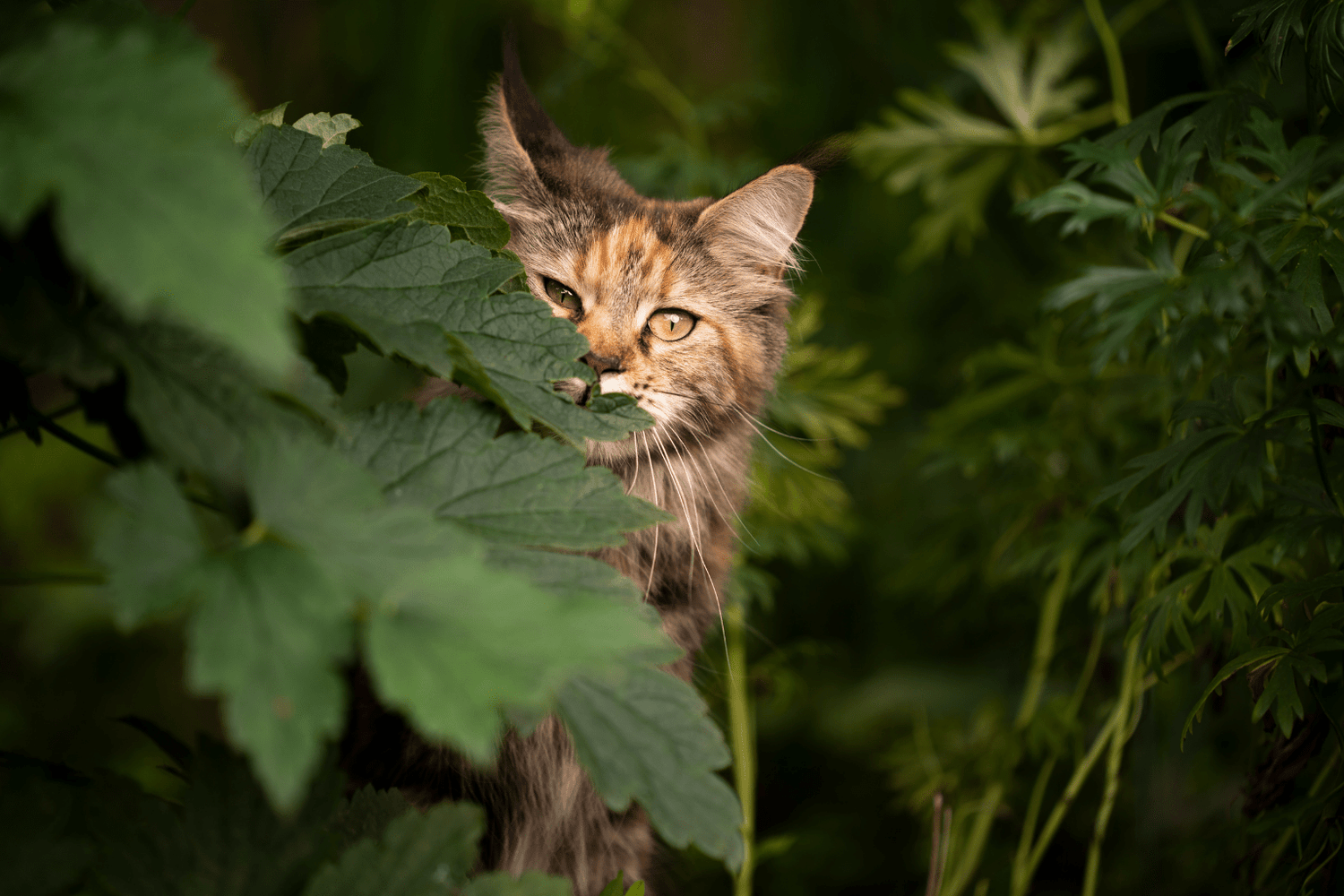Key Takeaways
- Cat chewing can be a normal exploratory behavior or a sign of a compulsive issue.
- Identifying the cause of chewing is important for addressing the behavior effectively.
- Natural remedies can help redirect destructive chewing habits in cats.
- Understanding cat chewing promotes a happier relationship between pet and owner.
Table of Contents
- Why Is My Cat Chewing? Understanding What's Normal vs. What's Not
- Under the Surface, Medical and Behavioral Causes of Problem Chewing
- Top Cat Chewing Hazards in Your Home (And How To Out-Smart Them)
- Solutions That Work, How to Stop Destructive Chewing (That You Can Start Today)
- Natural Remedies and Holistic Support for Cat Chewing
- When Cat Chewing Becomes an Emergency
- Managing Chewing Across Your Cat's Life Stages
Cat Chewing, Why Cats Chew, How To Help, and Natural Solutions for Healthier Habits
Finding your favorite sweater with mysterious holes or discovering your cat mid-chew on a houseplant can leave any pet parent puzzled. Cat chewing ranges from normal exploratory behavior to concerning compulsions that require intervention. Understanding the difference, and knowing how to redirect destructive habits naturally, keeps both you and your feline friend happier.
Most cats chew occasionally, but persistent or sudden changes in chewing patterns often signal underlying needs your cat can't communicate directly. Whether it's dental discomfort, stress, or simple boredom, the right approach can transform a furniture-destroying habit into healthy play.
For more tips on keeping your cat healthy and happy, check out how to exercise a lazy cat and encourage positive behaviors.
Why Is My Cat Chewing? Understanding What's Normal vs. What's Not
Cats use their mouths to explore the world differently than dogs. While dogs tend to be obvious about their chewing, cats often work in stealth mode, making it harder to catch problematic behaviors early.
Curiosity, Play, and Teething, The Normal Side of Chewing
Kittens between 3-8 weeks old naturally chew as their adult teeth emerge. This teething phase involves gentle gnawing on soft textures and typically resolves as permanent teeth settle in. Young cats also mouth objects to gather information about texture, taste, and safety, similar to how human toddlers explore.
Cassie, a rescue kitten from our community, spent her first month systematically "testing" every blanket corner in her foster home. Her gentle nibbling decreased naturally as she matured, shifting toward normal play behaviors instead.
Chewing Red Flags, When Chewing Becomes Excessive or Dangerous
Problematic cat chewing involves intensity, frequency, or target materials that pose risks. Watch for cats who chew aggressively enough to ingest non-food items, create wounds on themselves, or suddenly develop chewing habits after months of normal behavior.
Is Your Cat's Chewing Normal? Quick Check:
- Does the chewing cause visible damage to objects or your cat?
- Has the behavior appeared suddenly in an adult cat?
- Does your cat swallow non-food materials?
- Do you notice drooling, bad breath, or one-sided chewing?
- Does the chewing interfere with eating, sleeping, or social time?
If you answered "yes" to any question, your cat's chewing warrants closer attention.
What's Going On In Their Heads? The Psychology of Cat Chewing
Cats chew for emotional regulation just as much as physical needs. Boredom drives many indoor cats toward inappropriate targets, while stress can trigger compulsive behaviors like wool-sucking or cardboard shredding. Some breeds, particularly Siamese and Oriental cats, show genetic predispositions toward fabric chewing.
Environmental factors matter enormously. Rescue Rachel manages 30+ cats and noticed chewing incidents spike during feeding transitions or when new animals joined the group, clear signs that social stress influences oral behaviors.
Under the Surface, Medical and Behavioral Causes of Problem Chewing

Sudden or excessive cat chewing often stems from physical discomfort your cat can't verbalize. Identifying these underlying triggers helps you address the root cause rather than just managing symptoms.
Dental Pain and Oral Health Problems
Cats hide dental pain exceptionally well, but chewing patterns often reveal what they won't show otherwise. One-sided chewing, avoiding hard kibble, or suddenly preferring soft textures can indicate tooth problems, abscesses, or gum inflammation.
A simple monthly mouth check, gently lifting your cat's lip to observe gum color and tooth condition, helps catch issues early. Healthy gums appear pink, not red or swollen, and teeth should be white without brown tartar buildup.
For cats experiencing oral discomfort, our Cat Dental Care & Bad Breath Remedy supports gum comfort and overall oral hygiene naturally.
Pica and Obsessive Behaviors, Chewing What They Shouldn't
Pica involves eating non-food materials and poses serious health risks through intestinal blockages. Cats with pica commonly target fabric, rubber bands, plastic bags, or houseplants. Unlike normal chewing, pica involves actual consumption rather than just gnawing.
Wool-sucking represents a specific form often seen in early-weaned cats or certain breeds. These cats seek out sweaters, blankets, or upholstery for intensive sucking and chewing sessions that can last hours.
Underlying Triggers: Stress, Diet, and Medical Causes
Environmental changes frequently trigger new chewing habits. Moving homes, schedule disruptions, new pets, or even furniture rearrangement can prompt stress-related chewing. Nutritional deficiencies, particularly inadequate fiber or protein, may also drive cats toward inappropriate materials.
Medical conditions like hyperthyroidism, diabetes, or digestive disorders sometimes manifest as changed eating or chewing behaviors before other symptoms appear obvious.
To learn more about common health issues that may affect your cat, read our article on aging cat health issues.
Top Cat Chewing Hazards in Your Home (And How To Out-Smart Them)
Every home contains potential chewing targets that can pose serious risks to curious cats. Understanding these dangers helps you create a safer environment while satisfying your cat's natural urge to explore with their mouth.
| Common Chew Target | Risk Level | Main Dangers | Quick Prevention |
|---|---|---|---|
| Electrical cords | High | Electric shock, burns | Cord covers, unplug when not in use |
| Fabric/clothing | Medium | Intestinal blockage | Secure in closets, offer alternatives |
| Houseplants | High | Poisoning, organ damage | Remove toxic plants, add cat grass |
| Cardboard boxes | Low | Minor digestive upset | Monitor intake, provide fresh boxes |
| Plastic bags | High | Suffocation, choking | Store immediately after use |
Wires and Cords
Electrical cords present the most serious immediate danger to cats who chew. Beyond the risk of shock or burns, damaged cords create fire hazards for your entire household. Young cats especially target phone chargers and lamp cords because they're often at floor level and move slightly when touched.
Cord management requires a three-step approach. First, use split-loom tubing or spiral cable wrap to cover exposed wires, both available at hardware stores for under $10. Second, apply bitter apple spray or double-sided tape around cord areas, as most cats dislike these textures. Finally, unplug devices when not in use, removing both the temptation and the electrical danger entirely.
Fabric, Leather, Plastics, and Packaging
Soft materials pose a different but equally serious threat through intestinal blockage. Cats who swallow fabric fibers, leather pieces, or plastic fragments may develop obstructions requiring emergency surgery. Feline Fiona learned this lesson when her cat Max developed a fascination with hair ties, leading to a midnight vet visit and expensive removal procedure.
Prevention starts with strategic storage. Keep clothing in closed drawers or hampers with secure lids. Replace plastic shopping bags with reusable canvas versions that cats find less appealing. Create a designated "chew box" filled with safe alternatives like cardboard tubes, paper bags, or cat-approved fabric toys that you rotate weekly to maintain interest.
Houseplants and Human Foods
Many common houseplants contain compounds toxic to cats, with lilies being among the most dangerous, even pollen on their fur can cause kidney failure if groomed off. Other problematic plants include poinsettias, philodendrons, and rubber trees. Food packaging presents additional risks, as cats may chew through bread bags or cereal boxes to reach contents that could upset their digestive systems.
The safest approach involves removing all toxic plants and replacing them with cat-friendly alternatives like spider plants, Boston ferns, or dedicated cat grass. Store human food in sealed containers and dispose of packaging immediately. Many cat parents find success creating a "green zone" with multiple cat grass varieties, giving their pets a safe outlet for their plant-chewing instincts.
Solutions That Work, How to Stop Destructive Chewing (That You Can Start Today)
Addressing problematic cat chewing requires understanding the root cause and providing appropriate alternatives. Most destructive chewing stems from boredom, stress, or unmet hunting instincts rather than defiance or spite.
For cats whose chewing is triggered by anxiety or stress, Pet Relax Cat Calming Anxiety Relief can help support emotional balance and reduce destructive behaviors.
Environmental Enrichment for Busy Mouths
Active cats need mental stimulation to redirect their chewing energy productively. Schedule two 15-minute play sessions daily using toys that mimic prey movement, feather wands, laser pointers, or motorized mice work well. The key is consistency; cats thrive on routine and will begin anticipating these outlets for their energy.
Foraging games tap into natural hunting behaviors while keeping mouths busy. Hide small treats inside toilet paper tubes, create puzzle feeders from egg cartons, or stuff kibble into clean socks tied with knots. Rotate these activities weekly to prevent boredom. One simple DIY solution involves knotting an old t-shirt into a rope toy for supervised chewing sessions.
Safe Chewing Alternatives, What to Use (and What to Avoid)
Providing appropriate chewing options prevents cats from targeting inappropriate items. Cardboard scratchers serve double duty for scratching and light chewing, while paper bags offer crinkly textures many cats enjoy. Avoid cooked bones, which can splinter, and small rubber toys that pose choking hazards.
Bailey, a senior cat in our community, found relief from dental discomfort through a rotation of textured toys approved by her veterinarian. Her owner discovered that frozen washcloths provided soothing pressure for sore gums, while rope toys satisfied her need to gnaw. The key was supervision, never leaving Bailey alone with items that could unravel or break into pieces.
Redirection and Positive Reinforcement
When you catch your cat chewing something inappropriate, immediately offer an acceptable alternative without scolding. Use a calm, encouraging voice while presenting the substitute item, then praise your cat when they engage with the appropriate option. Consistent redirection teaches cats what's acceptable while maintaining their trust and reducing stress.
Natural Remedies and Holistic Support for Cat Chewing

When environmental changes and enrichment aren't enough, gentle natural support can help address the underlying causes of excessive cat chewing. Rather than masking symptoms, homeopathic remedies work with your cat's natural healing processes to restore balance and comfort.
The BestLife4Pets Approach to Chewing Support
Our homeopathic pellets target the root causes behind problematic chewing behaviors. Whether your cat is stress-chewing from environmental changes, experiencing oral discomfort, or showing signs of anxiety-driven pica, our gentle formulations support their body's natural ability to find equilibrium.
Why pellets work better than liquids: Cats are notoriously sensitive to taste and texture changes. Our tiny, odorless pellets dissolve quickly and can be easily mixed into food or given directly, making administration stress-free for both you and your feline friend.
Real Success Story: "After starting Luna on the Stress Support blend, her cardboard obsession decreased within two weeks. She's back to playing with her actual toys instead of destroying Amazon boxes." - Sarah M., Ontario
Targeted Support for Different Chewing Causes
For stress-related chewing: Our Pet Relax Cat Calming Anxiety Relief helps support emotional balance during transitions, new additions to the household, or schedule changes that trigger destructive behaviors.
For oral discomfort: Cat Dental Care & Bad Breath Remedy may help support oral comfort and mouth hygiene. Many pet parents notice fresher breath and more comfortable eating within days.
For senior cats: Cat Hip and Joint Pain Relief supports mobility and comfort, which sometimes helps reduce restlessness-driven chewing behaviors in older cats experiencing new discomfort.
Not a substitute for professional veterinary advice.
When Cat Chewing Becomes an Emergency
Most cat chewing episodes are harmless exploration, but certain situations require immediate veterinary attention. Recognizing these red flags can prevent serious complications and save your cat's life.
Recognizing Intestinal Blockages
Immediate danger signs: Repeated vomiting, inability to defecate, hunched posture, excessive drooling, or sudden lethargy after witnessing your cat chew and swallow non-food items. String, rubber bands, and fabric pieces are particularly dangerous as they can cause linear foreign body obstructions.
If you suspect your cat has swallowed something inappropriate, don't wait to see if it passes naturally. Contact your veterinarian immediately, even if it's after hours.
Plant and Chemical Poisoning
Cats who chew houseplants face serious toxicity risks. Lilies, poinsettias, and philodendrons can cause kidney failure, respiratory distress, or cardiac issues. Similarly, cats who chew electrical cords may suffer burns or internal injuries that aren't immediately visible.
Emergency action steps: Remove any remaining plant material from your cat's mouth, save a sample of what they chewed, and call your vet or pet poison control hotline immediately. Never induce vomiting unless specifically instructed by a veterinary professional.
Emergency Preparedness: Keep your vet's after-hours number and the Pet Poison Helpline (1-855-764-7661) easily accessible. Having this information ready saves precious minutes during a crisis.
For more information on feline behavior problems and destructive chewing, visit this authoritative resource from Cornell Feline Health Center.
Managing Chewing Across Your Cat's Life Stages
Chewing behaviors evolve as cats age, requiring different approaches at various life stages. Understanding these changes helps you provide appropriate support and intervention.
Kitten Teething (3-8 Months)
Young kittens experience the most intense cat chewing phase during teething. Provide frozen washcloths, small ice cubes, or kitten-safe chew toys to soothe sore gums. Rotate options daily to maintain interest and prevent boredom-driven destruction.
Supervise all chewing activities closely, as kittens haven't yet learned what's safe to ingest. Their smaller size makes them more vulnerable to blockages from even tiny objects.
For more on joint health and mobility as your cat ages, see our article on cat arthritis signs and symptoms.
Adult Cat Behavioral Chewing (1-7 Years)
Adult cats typically chew due to stress, boredom, or medical issues rather than teething discomfort. Focus on environmental enrichment, regular play sessions, and addressing any underlying health concerns through veterinary examination.
To explore natural supplement options for your cat's overall well-being, browse our collection of natural cat supplements.
Senior Cat Considerations (8+ Years)
Sudden onset chewing in senior cats often indicates dental pain, cognitive changes, or medication side effects. Schedule more frequent dental checkups and consider gentle support for age-related discomfort.
For additional scientific insight into feline chewing and oral behaviors, review this peer-reviewed article on feline oral health.
| Life Stage | Common Triggers | Best Solutions | When to Worry |
|---|---|---|---|
| Kitten (3-8 months) | Teething, exploration | Safe chew toys, frozen items | Swallowing non-food items |
| Adult (1-7 years) | Stress, boredom, medical issues | Environmental enrichment, play | Sudden behavior changes |
| Senior (8+ years) | Dental pain, cognitive changes | Frequent checkups, comfort support | New chewing patterns |
Frequently Asked Questions
What are the common reasons why cats chew, and how can I tell if my cat's chewing is normal or problematic?
Cats chew to explore their environment, relieve stress, or during teething as kittens. Normal chewing is usually gentle and occasional, often decreasing as they mature. Chewing becomes problematic when it is intense, frequent, or targets dangerous items, signaling a need for intervention.
How can I identify if my cat's chewing behavior is related to medical issues or emotional stress?
Look for changes in chewing patterns alongside other signs like drooling, pawing at the mouth, or sudden behavioral shifts. Medical issues like dental discomfort or emotional stress such as anxiety can increase chewing, so observing your cat’s overall health and mood helps pinpoint the cause.
What natural remedies and strategies can help redirect destructive chewing habits in cats?
Interactive toys, safe chew alternatives, and calming natural remedies can support healthy chewing habits. Providing mental stimulation and gentle homeopathic support helps ease stress and redirects chewing away from harmful objects.
When should I consider a cat's chewing behavior to be an emergency requiring immediate attention?
If your cat is chewing on toxic plants, electrical cords, or swallowing harmful materials, seek veterinary advice immediately. Sudden, intense chewing accompanied by signs of pain or distress also warrants prompt professional care.



